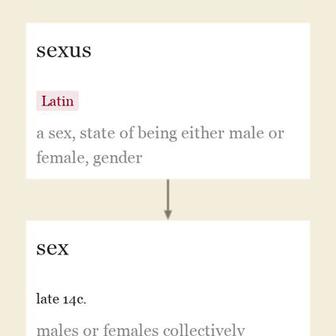sexist (adj.)
1965年,源自 sex(名词),模仿 racist 的方式创造,由美国宾夕法尼亚州兰开斯特市富兰克林和马歇尔学院特别项目主任保琳·M·利特在一次演讲中创造。该演讲在女权主义者中传阅。它在卡罗琳·伯德的《女性天生就是这样》(1968年)的介绍中被广泛使用,该书也引入了 sexism。
sexist 的相关词汇
1932年(作为形容词从1938年开始),源自 race(名词2)+ -ist。Racism(详见)在1928年开始使用,最初是在法西斯理论的背景下使用的,并且从1936年开始普遍使用。这些词替代了更早的 racialism(1882年)和 racialist(1910年),两者在20世纪初经常在英国或南非的背景下使用。有孤立的使用 racism 的情况可追溯到大约1900年。
Returning recently from a six months' visit to Europe, the Rev. John LaFarge, noted Catholic writer, warned at a dinner given in his honor that the destructive forces of "racism" are increasing in the United States, and that they could cause irreparable harm among the American people if immediate steps are not taken to combat them.
Father LaFarge said that American racism is directed principally against Negroes, Jews, and foreigners. He described it as "the pale but venomous cousin" of Nazi racism. Like its Nazi counterpart, he added, it has erected impassable barriers between extensive regions and large groups of people, has formed its own myths and moulded its own social institutions, and above all has come consistently into conflict with Christian teachings. [Opportunity, Journal of Negro Life, vol. XVII, No. 2, Feb. 1939]
最近从欧洲回来的天主教作家约翰·拉法基神父在一次为他举行的晚宴上警告说,“种族主义”的破坏力正在美国增长,如果不立即采取措施来对抗它们,它们可能会给美国人民带来不可挽回的伤害。
拉法基神父说,美国的种族主义主要针对黑人、犹太人和外国人。他将其描述为纳粹种族主义的“苍白但有毒的表亲”。他补充说,就像纳粹种族主义一样,它在广阔地区和大群人之间建立了无法逾越的障碍,形成了自己的神话并塑造了自己的社会制度,最重要的是,它始终与基督教教义发生冲突。[《机会》杂志,黑人生活期刊,第17卷,第2期,1939年2月]
早期,使用了 race hatred(1852年指巴尔干地区,1858年指英属印度,1861年指美国的白人和黑人), race prejudice(1867年指英属印度的英语,1869年指美国的白人和黑人,1870年指英国人对待爱尔兰人)等词语,尤其是在19世纪美国的政治背景下使用了 negrophobia。Anglo-Saxonism 作为“对英国种族优越性的信仰”从1860年开始使用(带有贬义)。Anti-Negro(形容词)在英国和美国英语中可以追溯到1819年。

14世纪末,"男性或女性被视为一个整体",源自拉丁语 sexus "性别,既可以是男性也可以是女性,性别",一个起源不明的词。"通常与 seco 一起被视为种族的分割或'一半'" [塔克尔],这将把它与 secare "分割或切割"联系起来(参见 section(名词))。
Secus seems the more original formation, but it is strange that the older texts only know sexus. The modern meaning of sectiō 'division' suggests that sec/xus might derive from secāre 'to sever', but the morphology remains unclear: does sexus go back to an s-present *sek-s- 'to cut up', or was it derived from a form *sek-s- of the putative s-stem underlying secus? [Michiel de Vaan, "Etymological Dictionary of Latin and the other Italic Languages," Leiden, 2008]
Secus 似乎是更原始的形式,但奇怪的是,早期的文本只知道 sexus。sectiō 的现代意义为“分割”表明 sec/xus 可能源自 secāre 的“切割”,但形态学仍不清楚: sexus 是否追溯到一个 s-现在分词 *sek-s- 的“切割”,还是源自 secus 下的假定 s-词干的形式 *sek-s-?[Michiel de Vaan,《拉丁语和其他意大利语的词源词典》,莱顿,2008]
1520年代记录了与动物有关的“具有男性或女性特征的品质或特性”; 到19世纪,这尤其指“男性和女性的解剖学区别,通过其生殖器官的生理特征和每个人在生殖中所扮演的角色。”到16世纪60年代,这一概念扩展到植物中与动物性别相对应的特征或结构。
It is curious that the Anglo-Saxon language seems to have had no abstract term for sex, which was expressed only severally as manhood or womanhood. [Thomas Wright, note to "Anglo-Saxon and Old English Vocabularies," 1884]
有趣的是,盎格鲁-撒克逊语似乎没有抽象的性别术语,只能分别表示为男子气概或女子气概。[托马斯·赖特,《盎格鲁-撒克逊语和古英语词汇》,1884年注]
特别是 the sex "女性性别,女性"(1580年代)。1906年出现了"性交"(have sex)的意义; 1933年提出了"生殖器官"的意义("形成的烟雾"),可能更早。1871年在人类学中出现了 Sex symbol ,似乎是首次将该术语应用于玛丽莲·梦露(1959年)。1954年出现了 Sex-kitten (布丽吉特·巴尔多)。1901年出现了 Sex object ,最初用于心理学; 1904年出现了 sex appeal 。
For the raw sex appeal of the burlesque "shows" there is no defense, either. These "shows" should be under official supervision, at the least, and boys beneath the age of eighteen forbidden, perhaps, to attend their performance, just as we forbid the sale of liquors to minors. [Walter Prichard Eaton, "At the New Theatre and Others: The American Stage, Its Problems and Performances," Boston, 1910]
对于滑稽戏的原始性感,没有任何辩护的余地。至少,这些"表演"应该受到官方监督,禁止18岁以下的男孩参加,就像我们禁止向未成年人出售酒精一样。[沃尔特·普里查德·伊顿,《在新剧院和其他地方:美国舞台,其问题和表演》,波士顿,1910年]
Sex-life 于1887年出现。1916年出现了 Sex-drive (1911年出现了 sex-impulse)。1894年出现了 Sex-education ; 1969年出现了 sex therapist ,在早期的使用中常常指的是马斯特斯和约翰逊。1907年出现了 Sex-crime ; 1895年出现了 sex-maniac ; 1931年出现了 sex-fiend (在纽约每日新闻的标题中)。
1968年; 参见 sexist + -ism。Sex-discrimination 可追溯至1916年。